Fiber-to-Chip Three-Dimensional Silicon-on-Insulator Edge Couplers with High Efficiency and Tolerance
Abstract
1. Introduction
2. Design and Simulation
3. Theoretical Calculation
3.1. Coupling Efficiency of the TE and TM Modes
3.2. Calculation of the Misalignment Tolerance
4. Fabrication and Measurement
4.1. Device Fabrication
4.2. Validation and Analysis
5. Conclusions
Author Contributions
Funding
Data Availability Statement
Conflicts of Interest
References
- Rickman, A. The commercialization of silicon photonics. Nat. Photonics 2014, 8, 579–582. [Google Scholar] [CrossRef]
- Son, G.; Han, S.; Park, J.; Kwon, K.; Yu, K. High-efficiency broadband light coupling between optical fibers and photonic integrated circuits. Nanophotonics 2018, 7, 1845–1864. [Google Scholar] [CrossRef]
- Yao, J.; She, X.; Li, B.; Wang, C.; Chen, K.; Huang, T.; Shu, X. Compact spot-size converter for low-loss coupling and miniaturization of interferometric fiber optic gyroscopes. Opt. Commun. 2019, 452, 321–326. [Google Scholar] [CrossRef]
- Staude, L.; Schilling, J. Metamaterial-inspired silicon nanophotonics. Nat. Photonics 2017, 11, 274–284. [Google Scholar] [CrossRef]
- Mu, X.; Wu, S.; Cheng, L.; Fu, H. Edge couplers in silicon photonic integrated circuits: A review. Appl. Sci. 2020, 10, 1538. [Google Scholar] [CrossRef]
- Mu, X.; Wu, S.; Cheng, L.; Fu, H.Y. Grating couplers on silicon photonics: Design principles, emerging trends and practical issues. Micromachines 2020, 11, 666. [Google Scholar]
- Hatori, N.; Shimizu, T.; Okano, M.; Ishizaka, M.; Yamamoto, T.; Urino, Y.; Mori, M.; Nakamura, T.; Arakawa, Y. A hybrid integrated light source on a silicon platform using a trident spot-size converter. J. Light. Technol. 2014, 32, 1329–1336. [Google Scholar] [CrossRef]
- Qi, W.; Yu, Y.; Zhang, X. On-chip arbitrary-mode spot size conversion. J. Light. Technol. 2020, 9, 4365–4372. [Google Scholar] [CrossRef]
- Ying, P.; Tan, H.; Zhang, J.; He, M.; Xu, M.; Liu, X.; Ge, R.; Zhu, Y.; Liu, C.; Cai, X. Low-loss edge-coupling thin-film lithium niobate modulator with an efficient phase shifter. Opt. Lett. 2021, 46, 1478–1481. [Google Scholar] [CrossRef]
- Yu, S.; Li, X.; Gui, C. 3D SOI edge coupler design for high tolerance. AIP Adv. 2023, 13, 025365. [Google Scholar] [CrossRef]
- Fritze, M.; Knecht, J.; Keast, C.; Fijol, J.; Jacobson, S.; Keating, P.; LeBlanc, J.; Fike, E.; Kessler, B.; Frish, M.; et al. Fabrication of three-dimensional mode converters for silicon-based integrated optics. J. Vac. Sci. Technol. B Microelectron. Nanometer Struct. Process. Meas. Phenom. 2003, 21, 2897–2902. [Google Scholar] [CrossRef]
- Liu, W.; Zhang, J.; Liu, L.; Dai, D.; Shi, Y. High efficiency silicon edge coupler based on uniform arrayed waveguides with un-patterned cladding. IEEE Photonics Technol. Lett. 2020, 32, 1077–1080. [Google Scholar] [CrossRef]
- Fang, Q.; Song, J.; Luo, X.; Tu, X.; Jia, L.; Yu, M.; Lo, G. Low Loss Fiber-to-waveguide converter with a 3-D functional taper for silicon photonics. IEEE Photonics Technol. Lett. 2016, 28, 2533–2536. [Google Scholar] [CrossRef]
- Rahim, A.; Spuesens, T.; Baets, R.; Bogaerts, W. Open-access silicon photonics: Current status and emerging initiatives. Proc. IEEE 2018, 106, 2313–2330. [Google Scholar] [CrossRef]
- Maegami, Y.; Okano, M.; Cong, G.; Suzuki, K.; Ohno, M.; Narushima, T.; Yokoyama, N.; Seki, M.; Ohtsuka, M.; Namiki, S.; et al. Simple and fully CMOS-compatible low-loss fiber coupling structure for a silicon photonics platform. Opt. Lett. 2020, 45, 2095–2098. [Google Scholar] [CrossRef]
- Abdul, R.; Jeroen, G.; Bertrand, S.; Jean-Marc, F.; Philippe, A. Open-access silicon photonics platforms in Europe. IEEE J. Sel. Top. Quantum Electron. 2019, 25, 8200818. [Google Scholar]
- Chen, X.; Milosevic, M.M.; Stankovic’, S.; Reynolds, S.; Bucio, T.D.; Thomson, D.J.; Gardes, F.; Reed, G.T. The emergence of silicon photonics as a flexible technology platform. Proc. IEEE 2018, 106, 2101–2116. [Google Scholar] [CrossRef]
- Aalto, T.; Cherchi, M.; Harjanne, M.; Bhat, S.; Heimala, P.; Sun, F.; Kapulainen, M.; Hassinen, T.; Vehmas, T. Open-access 3-µm SOI waveguide platform for dense photonic integrated circuits. IEEE J. Sel. Top. Quantum Electron. 2019, 25, 8201109. [Google Scholar] [CrossRef]
- He, A.; Guo, X.; Wang, K.; Zhang, Y. Low loss, large bandwidth fiber-chip edge couplers based on Silicon-on-Insulator platform. J. Light. Technol. 2020, 38, 4780–4786. [Google Scholar] [CrossRef]
- Larrea, R.; Gutierrez, A.M.; Griol, A.; Brimont, A. Fiber-to-chip spot-size converter for coupling to silicon waveguides in the O-Band. IEEE Photonics Technol. Lett. 2019, 30, 31–34. [Google Scholar] [CrossRef]
- Yang, Y.; Zhao, H.; Ren, X.; Huang, Y. Monolithic integration of laser onto multilayer silicon nitride photonic integrated circuits with high efficiency at telecom wavelength. Opt. Express 2021, 29, 28912–28922. [Google Scholar] [CrossRef]
- Zhu, J.; Huang, H.; Zhao, Y.; Li, Y.; Sheng, Z.; Gan, F. Efficient silicon integrated four-mode edge coupler for few-mode fiber coupling. Chin. Opt. Lett. 2022, 20, 011302. [Google Scholar] [CrossRef]
- Fang, Q.; Song, J.; Luo, X.; Yu, M. Mode-size converter with high coupling efficiency and broad bandwidth. Opt. Express 2011, 19, 21588–21594. [Google Scholar] [CrossRef]
- Chang, T.-H.; Zhou, X.; Tamura, H.; Huang, C.-L. Realization of efficient 3D tapered waveguide-to-fiber couplers on a nanophotonic circuit. Opt. Express 2022, 30, 31643–31652. [Google Scholar] [CrossRef] [PubMed]
- Liao, C.-W.; Yang, Y.-T.; Huang, S.-W.; Lee, M.-C.M. Fiber-core-matched three-dimensional adiabatic tapered couplers for integrated photonic devices. J. Light. Technol. 2011, 29, 770–774. [Google Scholar] [CrossRef]
- Zhang, W.; Ebert, M.; Reynolds, J.D.; Chen, B. Buried 3D spot-size converters for silicon photonics. Optica 2021, 8, 1102–1108. [Google Scholar] [CrossRef]
- Marchetti, R.; Lacava, C.; Carroll, L.; Gradkowski, K.; Minzioni, P. Coupling strategies for silicon photonics integrated chips. Photonics Res. 2019, 7, 201–239. [Google Scholar] [CrossRef]
- Tao, S.H.; Song, J.; Fang, Q.; Yu, M.B.; Lo, G.Q.; Kwong, D.L. Improving coupling efficiency of fiber-waveguide coupling with a double-tip coupler. Opt. Express 2008, 16, 20803–20808. [Google Scholar] [CrossRef]
- You, Y. The Study on Integrated Optical Waveguide and Fiber coupling Design. Ph.D. Thesis, Huazhong University of Science & Technology, Wuhan, China, 2013. [Google Scholar]
- Park, H.; Kim, S.; Park, J.; Joo, J.; Kim, G. A fiber-to-chip coupler based on Si/SiON cascaded tapers for Si photonic chips. Opt. Express 2013, 21, 29313–29319. [Google Scholar] [CrossRef]
- Fu, Y.; Ye, T.; Tang, W.; Chu, T. Efficient adiabatic silicon-on-insulator waveguide taper. Photonics Res. 2014, 2, 41–44. [Google Scholar] [CrossRef]
- Tang, M.; Park, J.-S.; Wang, Z.; Chen, S. Integration of III-V lasers on Si for Si photonics. Prog. Quantum Electron. 2019, 66, 1–18. [Google Scholar] [CrossRef]
- Rhee, H.-W.; Shim, J.; Kim, J.-Y.; Bang, D.J.; Yoon, H.; Kim, M.; Kim, C.C.; You, J.-B.; Park, H.-H. Direct optical wire bonding through open-to-air polymerization for silicon photonic chips. Opt. Lett. 2022, 47, 714–717. [Google Scholar] [CrossRef] [PubMed]
- Maegami, Y.; Takei, R.; Omoda, E.; Amano, T.; Okano, M.; Mori, M.; Kamei, T.; Sakakibara, Y. Spot-size converter with a SiO2 spacer layer between tapered Si and SiON waveguides for fiber-to-chip coupling. Opt. Express 2015, 23, 21287–21295. [Google Scholar] [CrossRef]
- Takei, R.; Suzuki, M.; Omoda, E.; Manako, S.; Kamei, T.; Mori, M.; Sakakibara, Y. Silicon knife-edge taper waveguide for ultralow-loss spot-size converter fabricated by photolithography. Appl. Phys. Lett. 2013, 102, 101108. [Google Scholar] [CrossRef]
- Holly, R.; Hingerl, K.; Merz, R.; Hudek, P. Fabrication of silicon 3D taper structures for optical fiber to chip interface. Microelectron. Eng. 2007, 84, 1248–1251. [Google Scholar] [CrossRef]
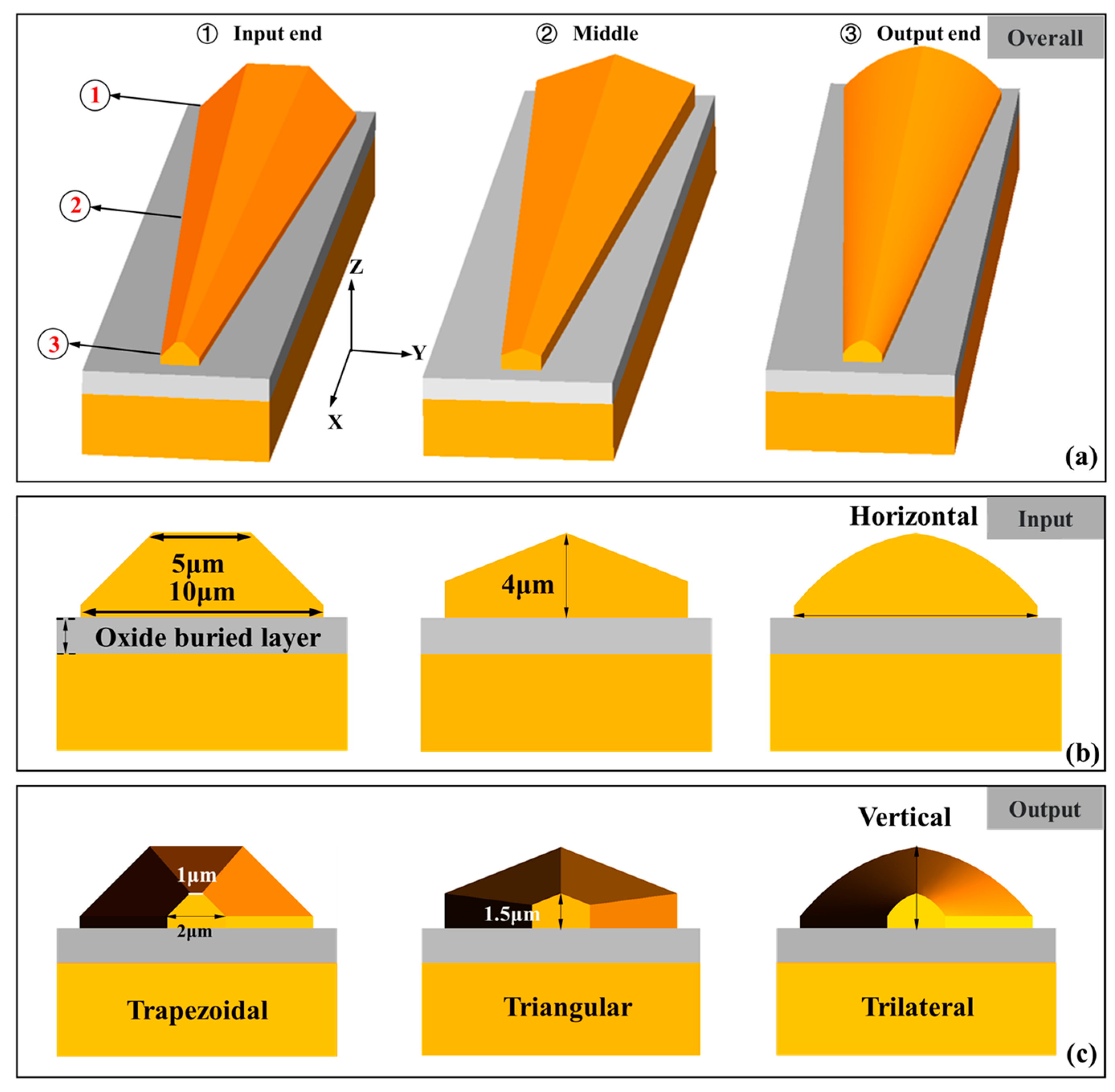


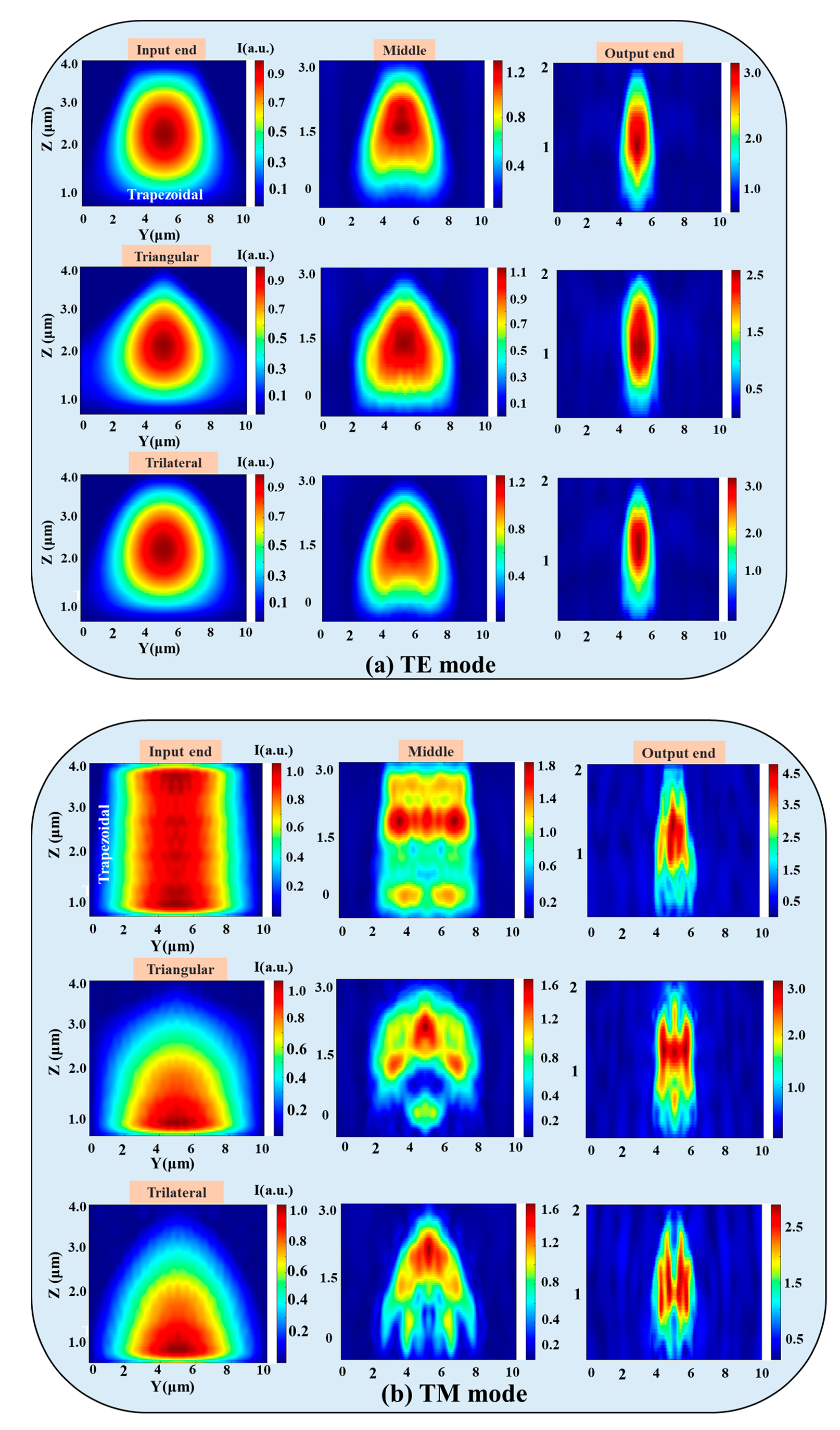
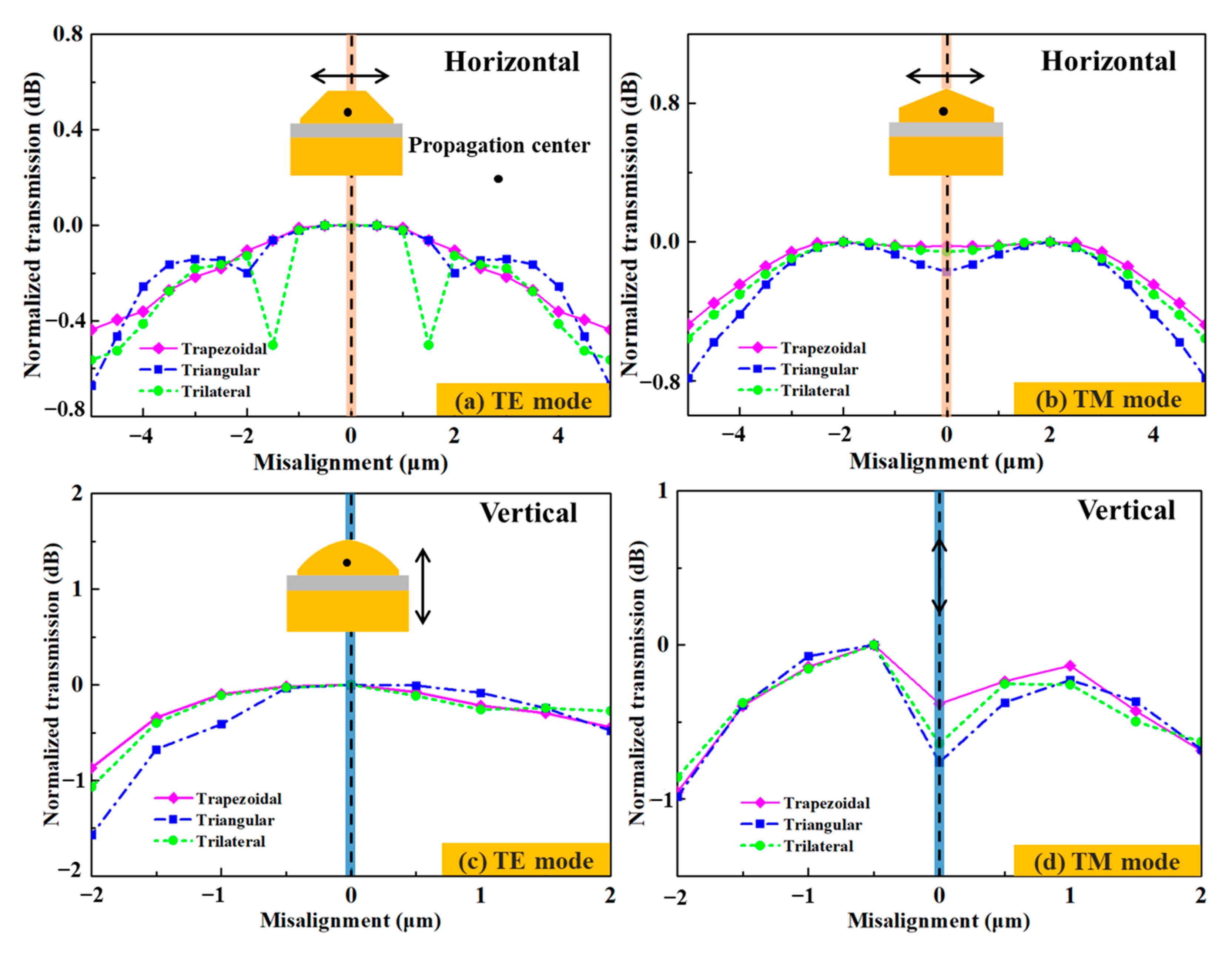


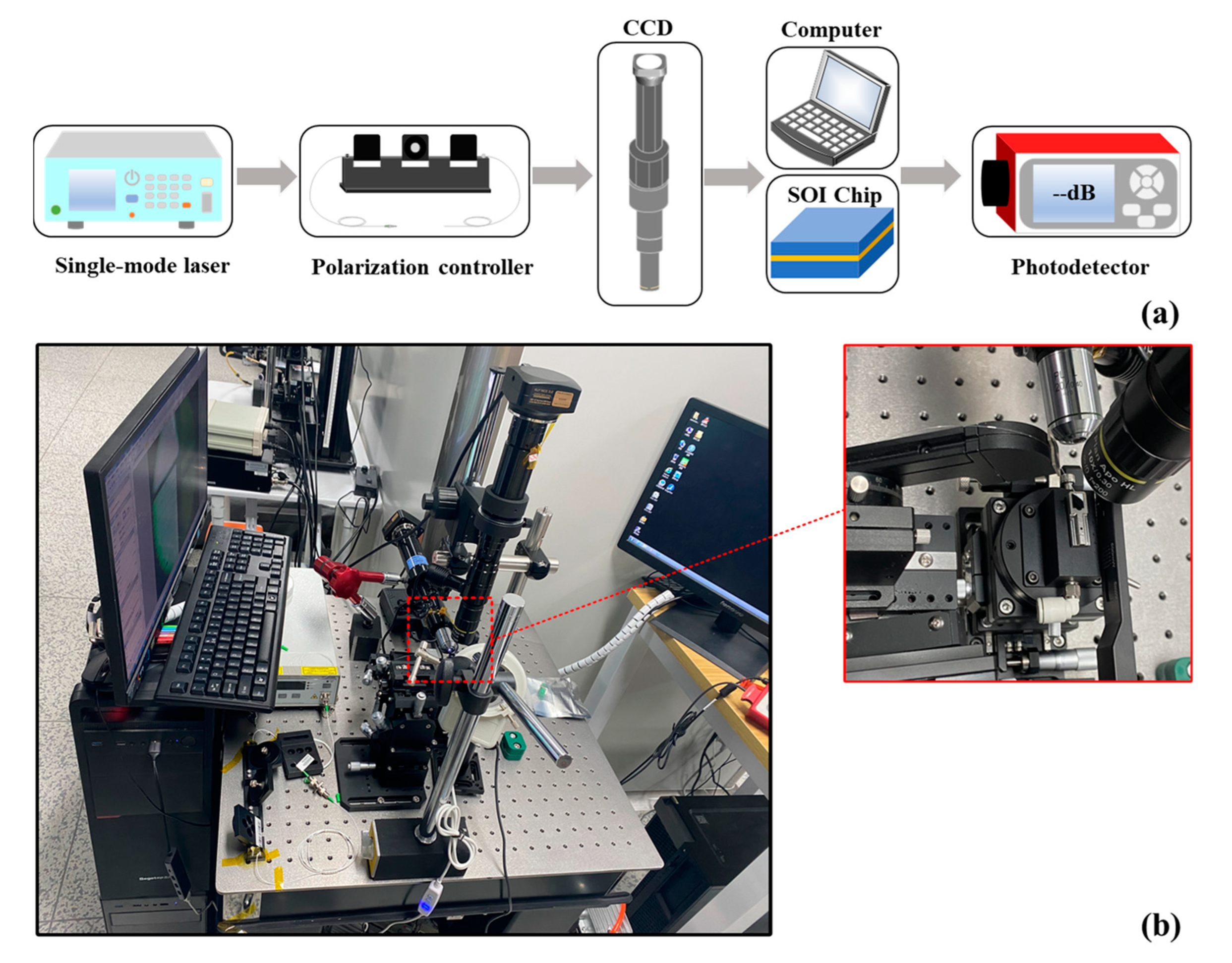
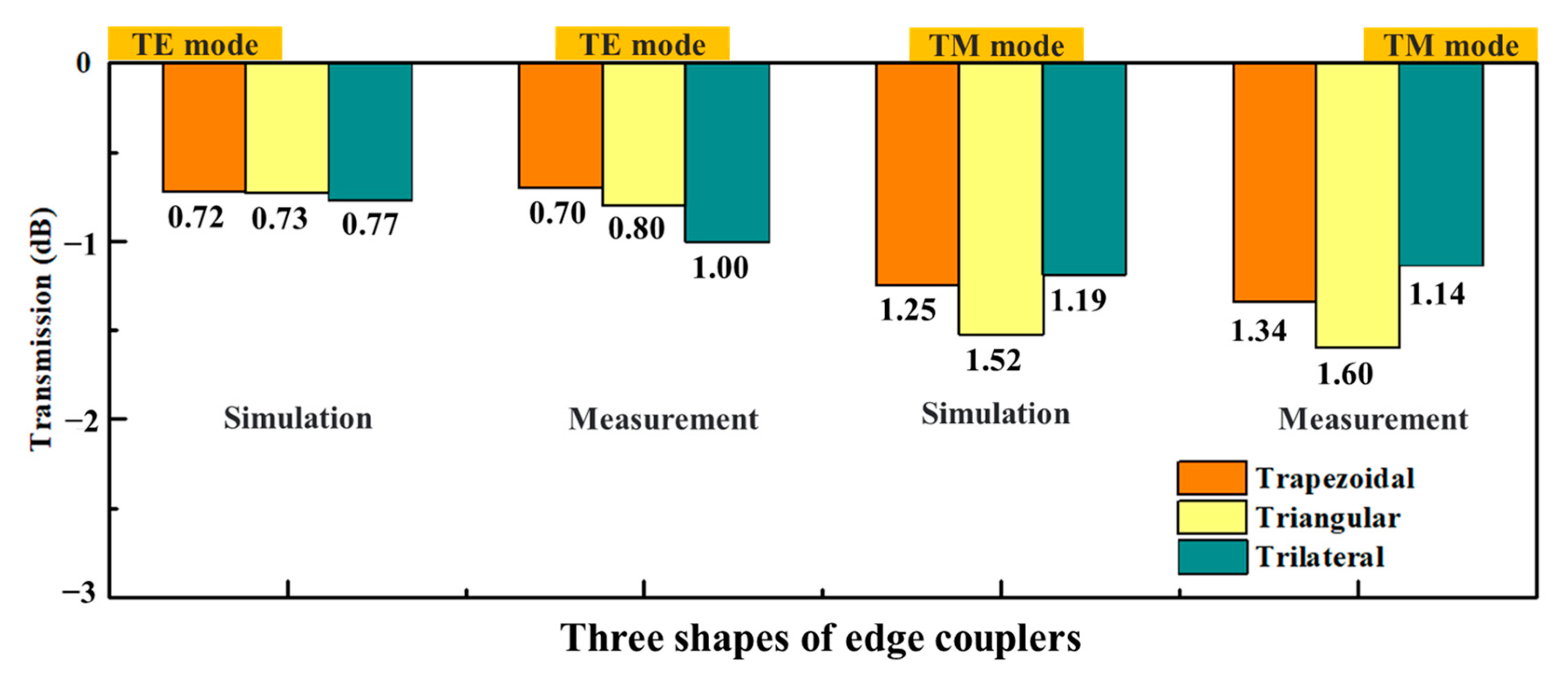

Disclaimer/Publisher’s Note: The statements, opinions and data contained in all publications are solely those of the individual author(s) and contributor(s) and not of MDPI and/or the editor(s). MDPI and/or the editor(s) disclaim responsibility for any injury to people or property resulting from any ideas, methods, instructions or products referred to in the content. |
© 2023 by the authors. Licensee MDPI, Basel, Switzerland. This article is an open access article distributed under the terms and conditions of the Creative Commons Attribution (CC BY) license (https://creativecommons.org/licenses/by/4.0/).
Share and Cite
Li, X.; Yu, S.; Gui, C. Fiber-to-Chip Three-Dimensional Silicon-on-Insulator Edge Couplers with High Efficiency and Tolerance. Micromachines 2023, 14, 1500. https://doi.org/10.3390/mi14081500
Li X, Yu S, Gui C. Fiber-to-Chip Three-Dimensional Silicon-on-Insulator Edge Couplers with High Efficiency and Tolerance. Micromachines. 2023; 14(8):1500. https://doi.org/10.3390/mi14081500
Chicago/Turabian StyleLi, Xiaoyu, Shengtao Yu, and Chengqun Gui. 2023. "Fiber-to-Chip Three-Dimensional Silicon-on-Insulator Edge Couplers with High Efficiency and Tolerance" Micromachines 14, no. 8: 1500. https://doi.org/10.3390/mi14081500
APA StyleLi, X., Yu, S., & Gui, C. (2023). Fiber-to-Chip Three-Dimensional Silicon-on-Insulator Edge Couplers with High Efficiency and Tolerance. Micromachines, 14(8), 1500. https://doi.org/10.3390/mi14081500





